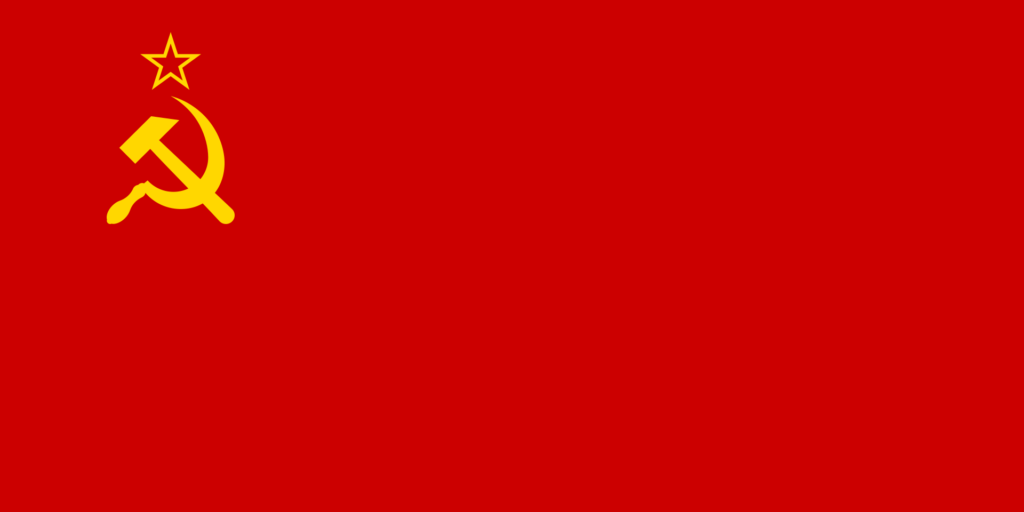
FROM WIKIPEDIA COMMONS
The Soviet Union, officially the Union of Soviet Socialist Republics (USSR), was a socialist state that spanned Eurasia during its existence from 1922 to 1991. It was nominally a federal union of multiple national republics; in practice its government and economy were highly centralized until its final years. The country was a one-party state (prior to 1990) governed by the Communist Party of the Soviet Union, with Moscow as its capital within its largest and most populous republic, the Russian SFSR. Other major urban centers were Leningrad (Russian SFSR), Kiev (Ukrainian SSR), Minsk (Byelorussian SSR), Tashkent (Uzbek SSR), Alma-Ata (Kazakh SSR) and Novosibirsk (Russian SFSR). It was the largest country in the world, covering over 22,402,200 square kilometres (8,649,500 sq mi), and spanning eleven time zones.
The Soviet Union had its roots in the October Revolution of 1917 when the Bolsheviks, headed by Vladimir Lenin, overthrew the Provisional Government that had earlier replaced the house of Romanov of the Russian Empire. They established the Russian Soviet Republic, the world’s first constitutionally guaranteed socialist state.[n] Tensions escalated into a civil war between the Bolshevik Red Army and many anti-Bolshevik forces across the former Empire, among whom the largest faction was the White Guard. The White Guard engaged in violent anti-communist repression against the Bolsheviks and suspected worker and peasant Bolsheviks known as the White Terror. The Red Army expanded and helped local Bolsheviks take power, establishing soviets, repressing their political opponents and rebellious peasants through Red Terror. By 1922, the balance of power had shifted and the Bolsheviks had emerged victorious, forming the Soviet Union with the unification of the Russian, Transcaucasian, Ukrainian and Byelorussian republics. Upon the conclusion of the civil war Lenin’s government introduced The New Economic Policy, which led to a partial return of a free market and private property; this resulted in a period of economic recovery.
Following Lenin’s death in 1924, Joseph Stalin came to power. Stalin suppressed all political opposition to his rule inside the Communist Party and inaugurated a command economy. As a result, the country underwent a period of rapid industrialization and forced collectivization, which led to significant economic growth, but also led to a man-made famine in 1932–1933 and expanded the Gulag labour camp system. Stalin also fomented political paranoia and conducted the Great Purge to remove his actual and perceived opponents from the Party through mass arrests of military leaders, Communist Party members, and ordinary citizens alike, who were then sent to correctional labor camps or sentenced to death.
On 23 August 1939, after unsuccessful efforts to form an anti-fascist alliance with Western powers, the Soviets signed a non-aggression pact with Nazi Germany. After the start of World War II, the formally neutral Soviets invaded and annexed territories of several Eastern European states, including eastern Poland and the Baltic states. In June 1941 the Germans invaded, opening the largest and bloodiest theater of war in history. Soviet war casualties accounted for the majority of Allied casualties of the conflict in the process of acquiring the upper hand over Axis forces at intense battles such as Stalingrad. Soviet forces eventually captured Berlin and won World War II in Europe on 9 May 1945. The territory overtaken by the Red Army became satellite states of the Eastern Bloc. The Cold War emerged in 1947, where the Eastern Bloc confronted the Western Bloc, which would unite in the North Atlantic Treaty Organization in 1949.
Following Stalin’s death in 1953, a period known as de-Stalinization and the Khrushchev Thaw occurred under the leadership of Nikita Khrushchev. The country developed rapidly, as millions of peasants were moved into industrialized cities. The USSR took an early lead in the Space Race with the first ever satellite and the first human spaceflight and the first probe to land on another planet, Venus. In the 1970s, there was a brief détente of relations with the United States, but tensions resumed when the Soviet Union deployed troops in Afghanistan in 1979. The war drained economic resources and was matched by an escalation of American military aid to Mujahideen fighters.
In the mid-1980s, the last Soviet leader, Mikhail Gorbachev, sought to further reform and liberalize the economy through his policies of glasnost and perestroika. The goal was to preserve the Communist Party while reversing economic stagnation. The Cold War ended during his tenure and in 1989, Warsaw Pact countries in Eastern Europe overthrew their respective Marxist-Leninist regimes. Strong nationalist and separatist movements broke out across the USSR. Gorbachev initiated a referendum—boycotted by the Baltic republics, Armenia, Georgia, and Moldova—which resulted in the majority of participating citizens voting in favor of preserving the Union as a renewed federation. In August 1991, a coup d’état was attempted by Communist Party hardliners. It failed, with Russian President Boris Yeltsin playing a high-profile role in facing down the coup. The main result was the banning of the Communist Party. The republics, led by Russia and Ukraine, declared independence. On 25 December 1991, Gorbachev resigned. All the republics emerged from the dissolution of the Soviet Union as independent post-Soviet states. The Russian Federation (formerly the Russian SFSR) assumed the Soviet Union’s rights and obligations and is recognized as its continued legal personality in world affairs.
The Soviet Union produced many significant social and technological achievements and innovations regarding military power. It boasted the world’s second-largest economy and the largest standing military in the world. The USSR was recognized as one of the five nuclear weapons states. It was a founding permanent member of the United Nations Security Council as well as a member of the OSCE, the WFTU and the leading member of the Council for Mutual Economic Assistance and the Warsaw Pact.
Before its dissolution, the USSR had maintained its status as a world superpower, alongside the United States, for four decades after World War II. Sometimes also called “Soviet Empire“, it exercised its hegemony in Eastern Europe and worldwide with military and economic strength, proxy conflicts and influence in developing countries and funding of scientific research, especially in space technology and weaponry.
TODAY’S ALMANAC
Question of the Day
Is the Christmas tree a Christian symbol? Where did it come from?Decorated trees were used in winter celebrations long before the advent of Christianity. Plants and trees that remained green all year had a special significance for people who lived in cold-winter climes. Ancient people hung evergreen boughs over their doors and windows. Some believed that evergreens kept witches, ghosts, evil spirits, and illness away. Romans decorated evergreen trees with trinkets and topped them with an image of their sun god. Druid sorcerers hung golden apples and lit candles on oak trees to celebrate the winter solstice. It is generally agreed that the use of an evergreen tree as part of Christian Christmas celebrations started 400 years ago in Germany and spread to most of northern Europe by the 19th century.
Advice of the Day
Tact is the ability to describe others as they see themselves. —Abraham Lincoln
Home Hint of the Day
Varnish is a mixture of resins, solvents, and drying agents. It creates a durable finish on wood, acceptable even for outdoors, but its lengthy drying time (typically 6 to 8 hours) diminishes its appeal.
Word of the Day
To catch a crabIn rowing when a stroke of the oar either misses the water or digs too deeply.
Puzzle of the Day
Why is a blacksmith the most dissatisfied of mechanics?Because he is always striking for pay.
Born
- Eli Whitney (inventor) – 1765
- Diego Rivera (artist) – 1886
- Elzie Crisler Segar (Popeye creator) – 1894
- Sammy Davis, Jr. (entertainer) – 1925
- Flip Wilson (comedian) – 1933
- Jim Morrison (lead singer of The Doors) – 1943
- Kim Basinger (actress) – 1953
- Dominic Monaghan (actor) – 1976
- Ian Somerhalder (actor) – 1978
- AnnaSophia Robb (actress) – 1993
Died
- Major Robert Lawrence (the first African American astronaut, was killed during training exercises) – 1967
- John Lennon (musician, founding member of The Beatles) – 1980
- John Glenn (astronaut, first American to orbit Earth) – 2016
- Caroll Spinney (puppeteer; best known for Big Bird and Oscar the Grouch) – 2019
Events
- American Federation of Labor is organized at Columbus, Ohio, with Samuel Gompers as first president– 1886
- American Bird Banding Association formed, first such society in U.S.– 1909
- The San Francisco Symphony Orchestra gave its first concert– 1911
- John McCrae’s In Flanders Fields poem was published– 1915
- U.S. declared war on Japan (WW II)– 1941
- Nine N.Y.C. newspapers shut down when International Typographical Union workers strike– 1962
- Musician and former Beatle John Lennon was shot and killed in New York City– 1980
- Russian leaders announced the dissolution of the Soviet Union– 1991
- Element 111, roentgenium, first created– 1994
- At three Anheuser-Busch properties (Merrimack, New Hampshire; St. Louis, Missouri; and Fort Collins, Colorado) 896 couples gathered to kiss under the mistletoe, setting a new Guinness World Record– 2019
Weather
- Icefalls at Gay Hill, Texas, averaged four to six inches in diameter– 1892
- 92 degrees Fahrenheit, Ojai, California– 1938
COURTESY www.almanac.com

There is noticeably a bundle to know about this. I assume you made certain nice points in features also.